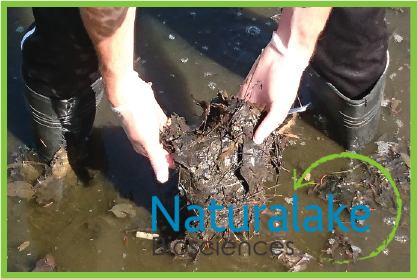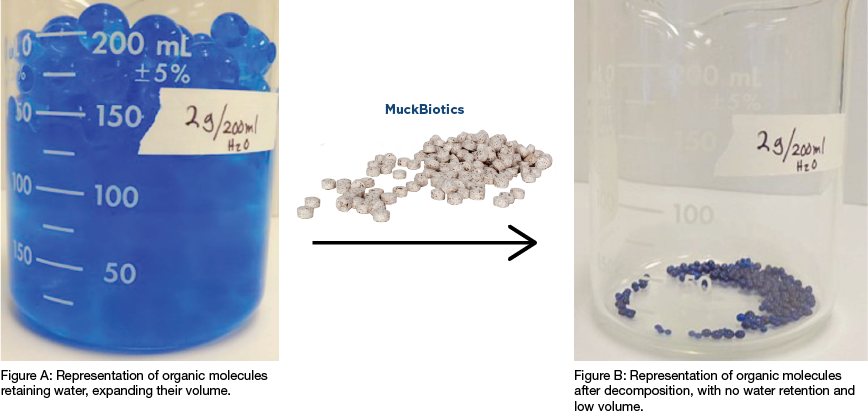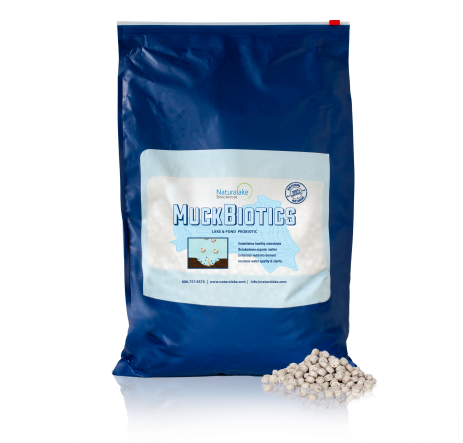This quite possibly could be the most common question we get here at Natural Lake Biosciences. Where does the muck go when MuckBiotics is used to break it down? While our scientists could spend hours talking about the technical details and complexities of this question, most of the inquires seem to be looking for an answer that is relatively simple and easy to understand. So, let’s get started with talking about muck.
Muck & The Issues Caused
Muck, sludge, detritus, sediment, and many other terms (although technically distinct) are commonly used to describe the combination of organic and inorganic matter found on the bottom of lakes, ponds, and other water resources. The organic portion is composed of a mixture of complex organic substrates from sources like dead algae, grass clippings, leaves, animal waste, and plants that make their way into the water body. These larger complex organic substrates retain a disproportionately high amount of water within them. The inorganic portion is composed of things like rock, gravel, sand, and clay that were either part of the foundation of the water body from the start or washed in over a period of time.
Both the organic and inorganic portion of muck can be problematic in lakes, ponds, and other water bodies. Muck buildup reduces water volumes or holding capacities, blocks drainage or inlet pipes, contributes to excess nutrient release and algal growth, and negatively impacts an assortment of recreational activities. While the inorganic portion can only be removed by physical means (heavy dredging equipment, hydro-raking, or similar), the organic portion can be removed or degraded within the water body using biological means.

Complex Organic Material Within Muck
- Dead Algae
- Grass clippings
- Leaves
- Animal waste
- Plants
How It’s Broken Down
MuckBiotics is a probiotic tablet that is designed to fully degrade the organic portion of the muck
using biological means. This innovative solution uses beneficial bacteria and stimulants to enhance the metabolic activity of the microbial community and reduces (degrades, digests, removes, decomposes) the organic portion of the muck. Through several phases of decomposition, the complex organic carbon substrates are turned into simpler organic molecules. The larger complex organic carbon substrates release water as they are broken down and simpler organic molecules are used by microorganisms in the muck layer. What is left of the muck layer after MuckBiotics has aided in the bacterial decomposition of the organic portion is primarily inorganic molecules and a small amount of simple organic molecules. The total volume and depth of the muck is decreased.
A great example of this process can be shown using polymer balls. The polymer balls in figure A represent the complex organic carbon substrate. Two grams of polymer balls absorbed 200ml of water and filled the entire volume of the beaker. In figure B, the polymer balls represent the simple organic molecules. This time, the same two grams of polymer balls have decomposed and released 200ml of water. The result is a dramatic decrease in the volume and depth of organic matter in the beaker!

Ultimately, using MuckBiotics is an effective and efficient way to target organic matter on the bottom of lakes, ponds, and other water resources. It can be used proactively to prevent muck buildup or reactively to restore water volume and depth.
Advanced Muck Removing Probiotic
Natural Lake Biosciences aims to develop pioneering biosciences to make safer water and better lives. Our team of scientists at our laboratory in the University of Wisconsin Research Park study microbial communities in aquatic ecosystems and their interactions with algae and aquatic plants. Their work ultimately leads to new innovations that augment existing technologies to make treatments easier and more effective.

